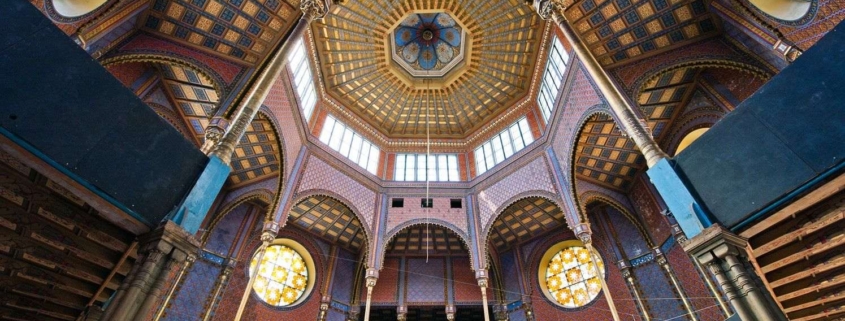This synagogue was built between 1869 and 1872 following the plans of Otto Wagner Viennese architect who was the leading figure of the secessionist movement. He designed a Moorish Revival synagogue. The building has eight sides, the octagonal, balconied, domed synagogue patterned and painted in Islamic style is beautiful. It was built as an homage to the style of the octagonal Dome of the Rock Muslim shrine in Jerusalem. You can find it in the 7th district just like the Kazinczy street Ortodox Synagogue and the Dohány street Grand Synagogue.
The Rumbach street synagogue belongs to the Status quo ante community which is one of the 3 biggest Jewish communities of Budapest. Since the beginning of the Hungarian history in Europe, since the end of the 9th century, there has been Jewish people living amongst the Hungarians. In the 1800s the Jewish community reached a point when they got separated into 3 communities. In 1868 there was a congress and the Neolog (the Grand Dohány street synagogue belongs to them), the Orthodox and the Status quo ante groups were born. Shortly the Orthodox community is the one that takes the rules of the religion the most seriously; the Neolog is the one that wanted to reform the ancient rules and traditions and assimilated to the Hungarians; and the Status quo ante is the group that wanted everything to stay as it was before, they are the so to say neutral community.
The Rumbach street synagogue served as a place where they collected Jewish people who were going to be deported to the death camp of Kamenyeck-Podolszk in 1941. The building got seriously damaged during the second World War and since 1959 they were not using it for religious purposes. What is more, in 1979 the roof broke by itself. Until 1980 people lived in the apartment building belonging to the temple, but they emptied it because it was too dangerous to stay in. A state-owned company bought it and in the 1990s they did some preserving works on it, but the renovation was not finished. In 2006 the Jewish community got it back, since then it could have been visited but renovation was still not complete. In 2007 they announced the result of the competition of the restoration and they just finished it in 2018. Now, there is a Torah-reading pulpit inside(similar to the main altar of catholic churches) that can go under the floor so that the synagogue can be used for other purposes as well that fit the spirituality of the building.



